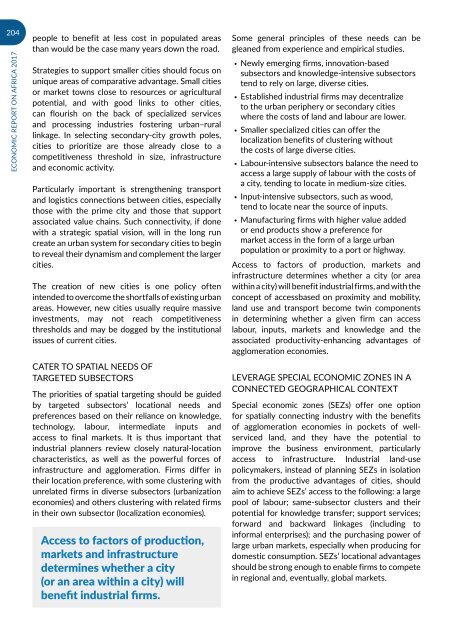URBANIZATION AND INDUSTRIALIZATION
Economic%20Report%20on%20Africa%202017%20UNECA
Economic%20Report%20on%20Africa%202017%20UNECA
You also want an ePaper? Increase the reach of your titles
YUMPU automatically turns print PDFs into web optimized ePapers that Google loves.
204<br />
ECONOMIC REPORT ON AFRICA 2017<br />
people to benefit at less cost in populated areas<br />
than would be the case many years down the road.<br />
Strategies to support smaller cities should focus on<br />
unique areas of comparative advantage. Small cities<br />
or market towns close to resources or agricultural<br />
potential, and with good links to other cities,<br />
can flourish on the back of specialized services<br />
and processing industries fostering urban–rural<br />
linkage. In selecting secondary-city growth poles,<br />
cities to prioritize are those already close to a<br />
competitiveness threshold in size, infrastructure<br />
and economic activity.<br />
Particularly important is strengthening transport<br />
and logistics connections between cities, especially<br />
those with the prime city and those that support<br />
associated value chains. Such connectivity, if done<br />
with a strategic spatial vision, will in the long run<br />
create an urban system for secondary cities to begin<br />
to reveal their dynamism and complement the larger<br />
cities.<br />
The creation of new cities is one policy often<br />
intended to overcome the shortfalls of existing urban<br />
areas. However, new cities usually require massive<br />
investments, may not reach competitiveness<br />
thresholds and may be dogged by the institutional<br />
issues of current cities.<br />
CATER TO SPATIAL NEEDS OF<br />
TARGETED SUBSECTORS<br />
The priorities of spatial targeting should be guided<br />
by targeted subsectors’ locational needs and<br />
preferences based on their reliance on knowledge,<br />
technology, labour, intermediate inputs and<br />
access to final markets. It is thus important that<br />
industrial planners review closely natural-location<br />
characteristics, as well as the powerful forces of<br />
infrastructure and agglomeration. Firms differ in<br />
their location preference, with some clustering with<br />
unrelated firms in diverse subsectors (urbanization<br />
economies) and others clustering with related firms<br />
in their own subsector (localization economies).<br />
Access to factors of production,<br />
markets and infrastructure<br />
determines whether a city<br />
(or an area within a city) will<br />
benefit industrial firms.<br />
Some general principles of these needs can be<br />
gleaned from experience and empirical studies.<br />
ҋҋ<br />
Newly emerging firms, innovation-based<br />
subsectors and knowledge-intensive subsectors<br />
tend to rely on large, diverse cities.<br />
ҋҋ<br />
Established industrial firms may decentralize<br />
to the urban periphery or secondary cities<br />
where the costs of land and labour are lower.<br />
ҋҋ<br />
Smaller specialized cities can offer the<br />
localization benefits of clustering without<br />
the costs of large diverse cities.<br />
ҋҋ<br />
Labour-intensive subsectors balance the need to<br />
access a large supply of labour with the costs of<br />
a city, tending to locate in medium-size cities.<br />
ҋҋ<br />
Input-intensive subsectors, such as wood,<br />
tend to locate near the source of inputs.<br />
ҋҋ<br />
Manufacturing firms with higher value added<br />
or end products show a preference for<br />
market access in the form of a large urban<br />
population or proximity to a port or highway.<br />
Access to factors of production, markets and<br />
infrastructure determines whether a city (or area<br />
within a city) will benefit industrial firms, and with the<br />
concept of accessbased on proximity and mobility,<br />
land use and transport become twin components<br />
in determining whether a given firm can access<br />
labour, inputs, markets and knowledge and the<br />
associated productivity-enhancing advantages of<br />
agglomeration economies.<br />
LEVERAGE SPECIAL ECONOMIC ZONES IN A<br />
CONNECTED GEOGRAPHICAL CONTEXT<br />
Special economic zones (SEZs) offer one option<br />
for spatially connecting industry with the benefits<br />
of agglomeration economies in pockets of wellserviced<br />
land, and they have the potential to<br />
improve the business environment, particularly<br />
access to infrastructure. Industrial land-use<br />
policymakers, instead of planning SEZs in isolation<br />
from the productive advantages of cities, should<br />
aim to achieve SEZs’ access to the following: a large<br />
pool of labour; same-subsector clusters and their<br />
potential for knowledge transfer; support services;<br />
forward and backward linkages (including to<br />
informal enterprises); and the purchasing power of<br />
large urban markets, especially when producing for<br />
domestic consumption. SEZs’ locational advantages<br />
should be strong enough to enable firms to compete<br />
in regional and, eventually, global markets.


